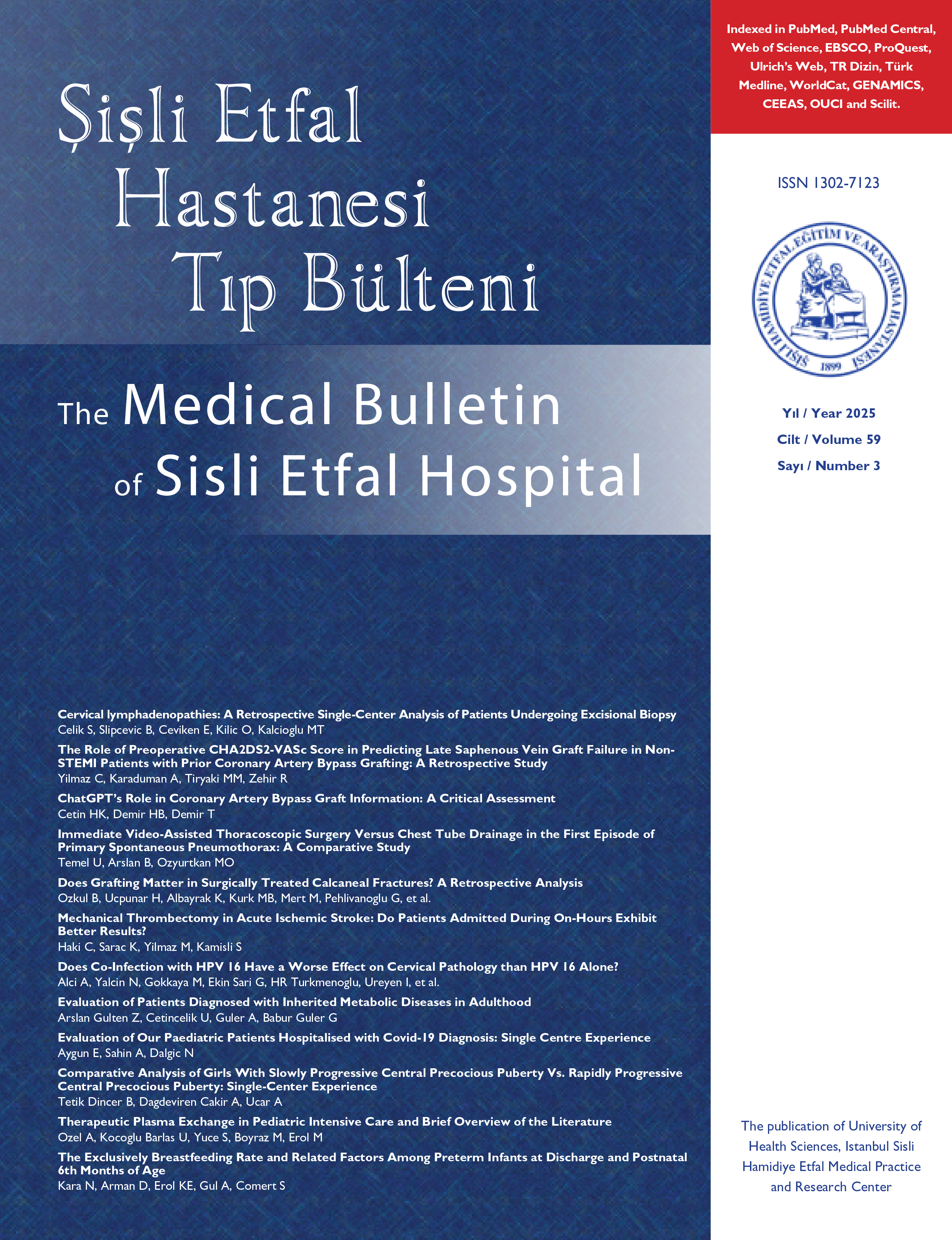
Effects of Oral Isotretinoin on Skin and Serum Levels of FoxO3, TRAIL and p53 and Metabolic Parameters
Yavuz Semiz1, Mehmet Alp Matur2, Damla Demir3, Ezgi Aktas21Department of Dermatology and Venereology, Sultangazi Haseki Training and Research Hospital, Istanbul, Türkiye2Department of Dermatology and Venereology, Prof. Dr. Cemil Tascioglu City Hospital, Istanbul, Türkiye
3Private Practice, Damla Demir Dermatology Clinic, Istanbul, Türkiye
Objectives: Isotretinoin-mediated apoptosis is considered the main cause of anti-acne side effects of isotretinoin. The aim of this study is to investigate the effects of oral isotretinoin therapy on the skin and serum levels of forkhead box transcription factor (FoxO)-3, tumor necrosis factor-related apoptosis-inducing ligand (TRAIL), p53 and metabolic parameters and examining the relationship between these parameters.
Methods: Sixteen acne vulgaris patients who were administered the appropriate cumulative dose of oral isotretinoin were enrolled in this prospective study.
Results: The decreases in the values of body mass index, waist circumference, systolic blood pressure, CRP, and ferritin from the baseline to the end of the treatment were statistically significant (p=0.028, p=0.029, p=0.008, p=0.046, and p=0.003, respectively). The increases in the levels of serum low density lipoprotein-cholesterol (LDL-C), triglyceride (TG), total cholesterol, gamma glutamyl transferase (GGT), and FoxO3 from the baseline to the end of the treatment were statistically significant (p=0.001, p=0.004, p<0.001, p=0.010, p=0.007, respectively). In terms of changes from the baseline to the end of the treatment, serum FoxO3 levels were positively correlated with the changes in serum TRAIL levels (r=0.674, p=0.004). The changes in serum FoxO3 levels were positively correlated with the changes in fasting blood glucose levels (r=0.540, p=0.031). The changes in serum TRAIL levels were positively correlated with the changes in the values of systolic BP (r=0.552, p=0.027) and diastolic BP (r=0.511, p=0.043). The changes in serum p53 levels and serum LDL-C levels were also positively correlated (r=0.499, p=0.049).
Conclusion: Isotretinoin therapy caused an increase in skin and serum levels of FoxO3 and TRAIL and a decrease in serum and skin p53 values. However, only the increase in serum FoxO3 levels was statistically significant. The observed reduction in p53 levels implies that the isotretinoin-related side effects may not rely on p53-mediated apoptosis, and it may be considered that its safety profile is better than expected. The correlations between the changes during isotretinoin therapy in metabolic parameters and TRAIL, p53, and FoxO3 values suggest that isotretinoin's metabolic side effects may involve these molecules.
Oral Isotretinoinin Deri ve Serum FoxO3, TRAIL, p53 Seviyeleri ve Metabolik Parametreler Üzerine Etkileri
Yavuz Semiz1, Mehmet Alp Matur2, Damla Demir3, Ezgi Aktas21Sultangazi Haseki Eğitim ve Araştırma Hastanesi, Dermatoloji ve Venereoloji Kliniği, İstanbul2Dr. Cemil Taşçıoğlu Şehir Hastanesi, Dermatoloji ve Venereoloji Kliniği, İstanbul
3Özel Muayenehane, Damla Demir Dermatoloji Kliniği, İstanbul
Amaç: İsotretinoin aracılı apoptozun, isotretinoinin anti-akne yan etkilerinin ana nedeni olduğu düşünülmektedir. Bu çalışmanın amacı, oral isotretinoin tedavisinin forkhead box transkripsiyon faktörü (Fox)-O3, tümör nekroz faktörü ilişkili apoptozu indükleyen ligand (TRAIL), p53ün deri ve serum düzeyleri ve metabolik parametreler üzerindeki etkilerini araştırmak ve bu parametrelerin birbirleriyle olan ilişkisini incelemektir.
Yöntemler: Oral isotretinoin tedavisini uygun kümülatif dozda alan 16 akne vulgaris hastası bu prospektif çalışmaya dahil edilmiştir.
Sonuçlar: Tedavi sonunda başlangıca kıyasla, vücut kitle indeksi, bel çevresi, sistolik kan basıncı, C-reaktif protein (CRP) ve ferritin değerlerindeki azalmalar istatistiksel olarak anlamlıydı (sırasıyla p=0.028, p=0.029, p=0.008, p=0.046 ve p=0.003). Tedavi sonunda başlangıca kıyasla serum düşük yoğunluklu lipoprotein kolesterol (LDL-C), trigliserid (TG), toplam kolesterol, gama glutamil transferaz (GGT) ve FoxO3 seviyelerindeki artışlar istatistiksel olarak anlamlıydı (sırasıyla p=0.001, p=0.004, p<0.001, p=0.010, p=0.007). Tedavi başlangıcı ve sonu arasındaki değerler incelendiğinde, serum FoxO3 seviyelerindeki değişimler serum TRAIL seviyelerindeki değişimlerle pozitif korelasyon gösterdi (r=0.674, p=0.004). Serum FoxO3 düzeylerindeki değişiklikler, açlık kan şekeri düzeylerindeki değişikliklerle pozitif korelasyon gösterdi (r=0.540, p=0.031). Serum TRAIL düzeylerindeki değişiklikler, sistolik kan basıncı (r=0.552, p=0.027) ve diyastolik kan basıncı (r=0.511, p=0.043) değerlerindeki değişikliklerle pozitif korelasyon gösterdi. Serum p53 düzeyleri ile serum LDL-C düzeylerindeki değişiklikler de pozitif korelasyon gösterdi (r=0.499, p=0.049).
Sonuç: İsotretinoin tedavisi, deri ve serum FoxO3 ve TRAIL seviyelerinde artışa, deri ve serum p53 değerlerinde ise azalmaya neden olmuştur. Ancak, sadece serum FoxO3 seviyelerindeki artış istatistiksel olarak anlamlıydı. p53 düzeylerindeki gözlenen azalma, isotretinoine bağlı istenmeyen yan etkilerin sadece p53 aracılı apoptoza bağlı olmadığını düşündürmekte ve bu durum ilacın güvenlik profilinin sanıldığından iyi olduğunu düşündürmektedir. İsotretinoin tedavisi sonrası metabolik parametrelerdeki değişim ile serum TRAIL, p53 ve FoxO3 değerlerindeki değişim arasındaki korelasyonlar, isotretinoinin metabolik yan etkilerinin bu moleküller ile ilgili olabileceğini düşündürmektedir. (SETB-2024-09-144)
Manuscript Language: English



















